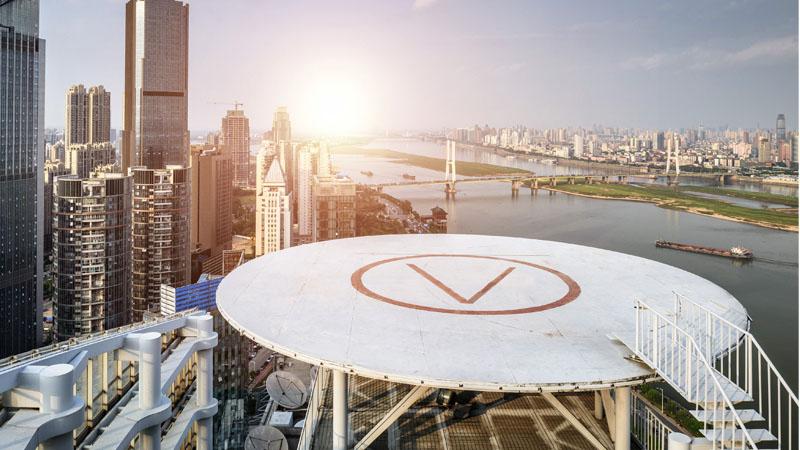Vertiports and eVTOLs: Weather challenges for the future of advanced mobility
As the pioneering future of Advanced Air Mobility (AAM) becomes reality, Vaisala is committed to providing innovative tools that help pilots, vertiport operators and others to understand and mitigate the impact of weather from the ground up.
In a recent episode of the eVTOL Insights Podcast, host Jason Pritchard interviewed Fernando Trolia Slamic, Director of Strategy and Business Development for Vaisala's Weather and Environment, to discuss how our weather and environmental monitoring instruments and insights are relevant to the electric vertical takeoff and landing (eVTOL) aircrafts and Advanced Air Mobility (AAM) markets. Below is an excerpt from their talk (edited for clarity).
To learn more, join our expert panel discussion about safety and efficiency for traffic planning and operations in Advanced Air Mobility (AAM).
Jason asks: Vaisala is looking to enter the emerging Advanced Air Mobility market, so could you please tell our audience what value Vaisala can bring and why?
Fernando answers: We have been engaged at various publicly funded and private initiatives in this industry around the world for the past four years, as well as working with relevant authorities. In the last 12 months, we’ve seen a strong acceleration that is manifested by, for example, the entry of more traditional players — some of whom are our customers and partners in traditional aviation — but also new entrants, providing fit-for-purpose solutions for the challenges that eVTOLs and vertiports need to sort out for safety and efficiency.
EVTOL operations face a unique set of weather phenomena: Visibility, temperature, icing, heavy rain, and especially wind conditions can vary greatly from the ground to different heights, because buildings and other urban landscape features affect local conditions. General forecasts are not enough — ultra-local weather insights provide the data needed for effective decision making.
With our in-depth experience with airport and urban weather measurement needs, we offer a wide range of innovative, configurable technology to suit vertiports and other eVTOL operation locations of any size, geography and climate.
Jason asks: With that in mind, are there any particular systems from Vaisala that can benefit the aviation sector?
Fernando answers: The most common solutions are the ICAO-recommended Automated Weather Observation Systems (AWOS) for sensing, data feeds and visualization solutions, which we offer as the comprehensive Vaisala AviMet® suite. We’re also deploying instruments and insights for icing detection and other critical challenges such as windshear and wake vortex detection, which enable significant increases in capacity and traffic output without compromising safety.
Jason asks: Other weather factors for eVTOL aircrafts include wind and extreme temperatures such as icing. What challenges do these pose, and are you able to share any insights from Vaisala about this?
Fernando answers: Yes, we’ve learned with our partners that short-term wind gusts and vortices around built infrastructure pose threats that traditional airports don’t face. Icing in particular, as well as visibility, are also critical aspects to take into account for eVTOL aircraft that don’t have the thrust of a plane or a helicopter. We concluded that ultra-local weather awareness and alerts provide the critical real-time information that operators and pilots need for effective decision making, with unprecedented accuracy and low latency in the aviation industry.
Jason asks: Weather monitoring is going to be crucial for this market, especially as we want eVTOL aircraft to be operational in all conditions. What would you say are the key considerations companies need to look out for in order to be as efficient as possible?
Fernando answers: We’re aware that vertiports cannot economically carry the investments and operating costs of the weather infrastructure and service of traditional airports, but also that operators don’t actually need those because their weather challenges and operational conditions are very different.
We believe that infrastructure developers can benefit greatly from early assessments at the planning stages to secure the highest levels of service availability — from determining the best locations across urban spaces, to understanding the predominant micro-weather conditions — for defining the best approach paths and service windows. Then, in the operational phase, understanding and using the best-fit weather solutions (sensors & data) for the particular environmental constraints and desired traffic density of every vertiport can help define the optimal solutions for strong economics.
Jason asks: Any final thoughts?
Fernando answers: We’re excited with the developments we see in this new industry which are strongly signaled by, for example, the entrance of traditional OEMs in the aircraft space, the convergence of traffic management rules and solutions driving emergent regulations.
From our own trials and studies, we’ve learned that micro-weather phenomena that both eVTOLs and vertiports will deal with is fundamentally different from those at airports, but the good news is that existing technologies have demonstrated they can empower operators to tackle these challenges without compromising healthy business-case economics, while making no compromises on maximum safety. We believe this industry has entered an operational level of maturity and is taking solid steps forward for a bright future.
Jason asks: How can our audience get more information?
Fernando answers: The first point contact we recommend is going to our website to find more information about our solutions. They can also contact us directly at [email protected].
Myself and our team can also help interested listeners to delve deeper into these topics and help them understand their particular situation and options from the weather perspective, getting them in contact with our technical experts as well as local representatives and partners globally.

